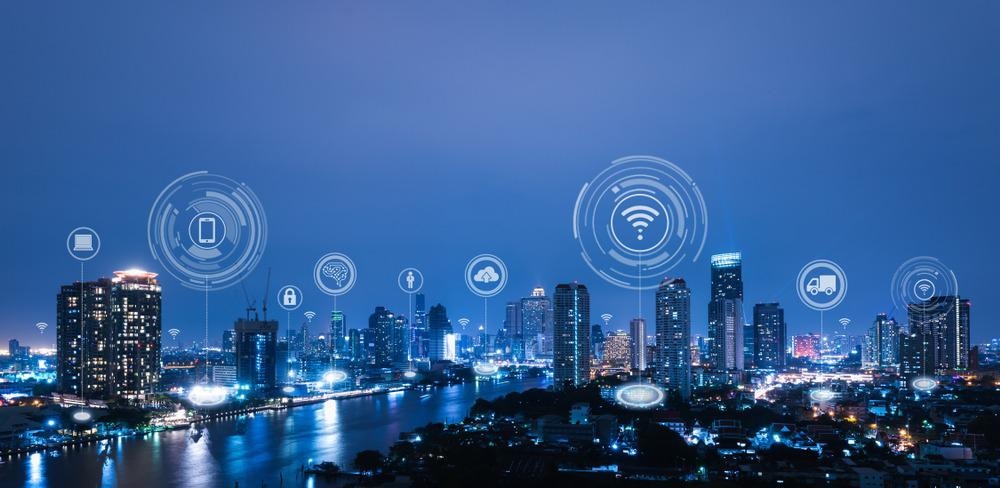
Image Credit: Vasin Lee/Shutterstock.com
Everything in a smart city is interconnected via a network of sensors or electronic devices that gather data; this data is used to improve the functioning of the city. But this can be complicated and expensive if not thoroughly tested first.
Just like their precursor, simulation, digital twins are a way of creating a virtual depiction of something in the real world such as a car or city. Smart cities can utilize digital twin technology to determine how the smart network might work, make adaptations and iron out any kinks, and determine the benefits.
What is a Smart City?
Smart cities are urban areas that integrate information and communication technology, sensors, and other electronic devices connected to the Internet of Things (IoT) to gather a wide range of data that can be used to optimize resources and services.
A network of sensors and devices positioned around the smart city collects information on environmental conditions, air quality, pollution, noise and traffic, while others gather data on irrigation systems, energy usage, and distribution.
This data can be analyzed and used to manage traffic and transport systems, power plants, waste and utilities, water supply networks, and community services such as schools, libraries, and hospitals.
Digital Twin Technology
Digital twin technology is a novel way of thinking about uniting and synchronizing product lifecycle management. Although the term was first coined in 2002, its only recently that it has grown in popularity thanks to developments in data integration, artificial intelligence (AI), and the internet of things (IoT), which permit collaboration and improved workflow across different groups and different disciplines.
The technology is among the top five strategic technology trends for 2021 as listed by Accenture. According to Michael Biltz, Accenture Technology Labs managing director, “businesses are finally figuring out how to scale these projects across a fleet of projects, rather than a single one-off”.
The technology has been championed for its ability to monitor and streamline data and it has been quickly adopted by many industries and enterprises. Multiple digital twins can be linked to generate a model of a factory, a place such as a port, or a city. Their use help accelerate vehicle electrification, reduce the cost of construction, and aid the design and building of smart cities.
Success in Singapore
Singapore’s National Research Foundation (NRF) has successfully used digital twin technology to create a virtual representation of Singapore. They implemented 3D semantic modeling - which is able to display detail down to roads, curbs, and stairs are they are - to unite map and land data with real-time information on demographics, climate and traffic to create an exact model of the city.
The digital twin is used as a tool for testing urban designs to increase accessibility in certain areas. Information gathered during testing can be used to determine how to provide the best results without actually having to carry out any construction work.
The technology is helpful in simulating emergency evacuation scenarios in shopping centers or stadiums, for example, to develop better protocols and establish the best evacuation methods. Further applications include analyzing traffic, transit, and pedestrian movement patterns to make transport more efficient and to make adjustments based on real-world requirements.
It allows the NRF to see how other twins of physical objects within the city-state could be integrated. The district of Yuhua has used the digital twin to plan and monitor urban development and visualize how various pedestrian bridge designs over one of its main roads could be integrated into a nearby park.
The district has also used digital twins to monitor the GreenPrint project, a sustained area fitted with solar panels, LED lights, a pneumatic waste conveyance system and pedestrian and cyclist networks. This can provide insights into if and how it could be implemented in other districts.
The Future of Digital Twin Technology
Smart cities are complex and costly, but digital twin technology can be implemented to minimize, or even remove, some of the risks associated with urban development. A network of sensors distributed around the city can monitor any number of parameters and help optimize the functioning of the city for the benefit of citizens.
References and Further Reading
Lawton, G. (2021) Why Accenture lists ‘digital twins’ as top-five technology trend in 2021, VentureBeat, https://venturebeat.com/2021/03/12/why-accenture-lists-digital-twins-as-top-five-technology-trend-in-2021/. Accessed 19 April 2021.
Accenture (2021), Technology Trends 2021, https://www.accenture.com/us-en/insights/technology/_acnmedia/Thought-Leadership-Assets/PDF-4/Accenture-Tech-Vision-2021-Full-Report.pdf. Accessed 19 April 2021.
Liceras, P. (2019) Singapore experiments with its digital twin to improve city life, Tomorrow: https://www.tomorrow.city/a/singapore-experiments-with-its-digital-twin-to-improve-city-life. Accessed 19 April 2021.
Disclaimer: The views expressed here are those of the author expressed in their private capacity and do not necessarily represent the views of AZoM.com Limited T/A AZoNetwork the owner and operator of this website. This disclaimer forms part of the Terms and conditions of use of this website.